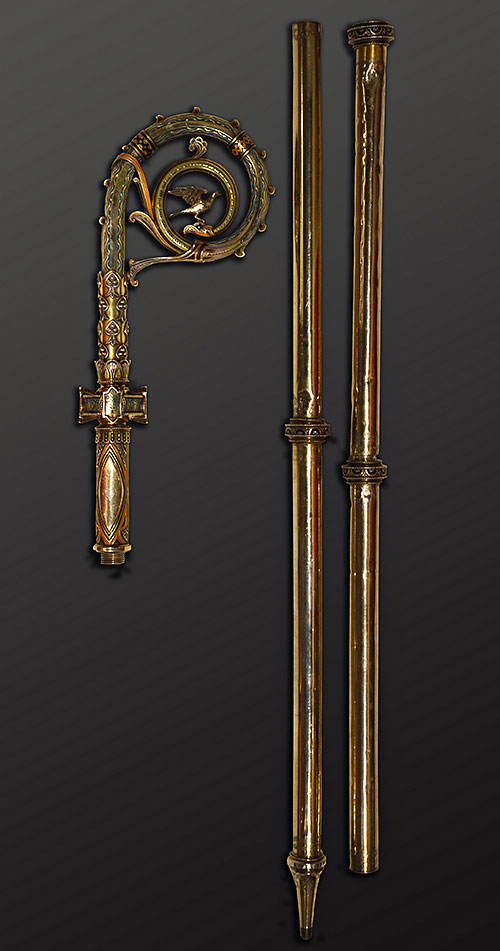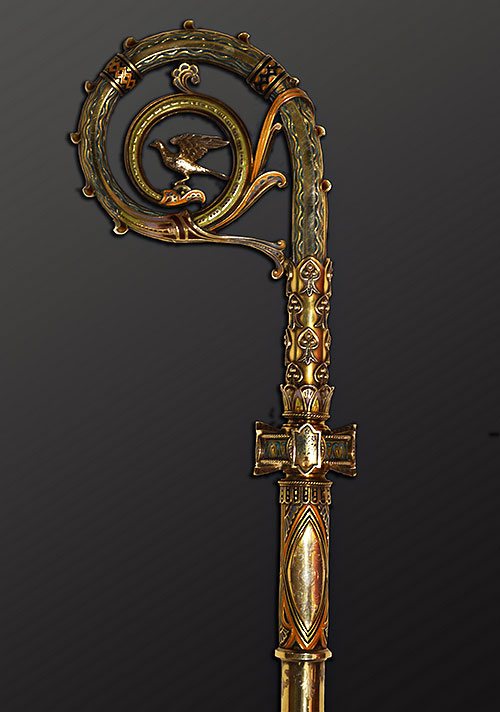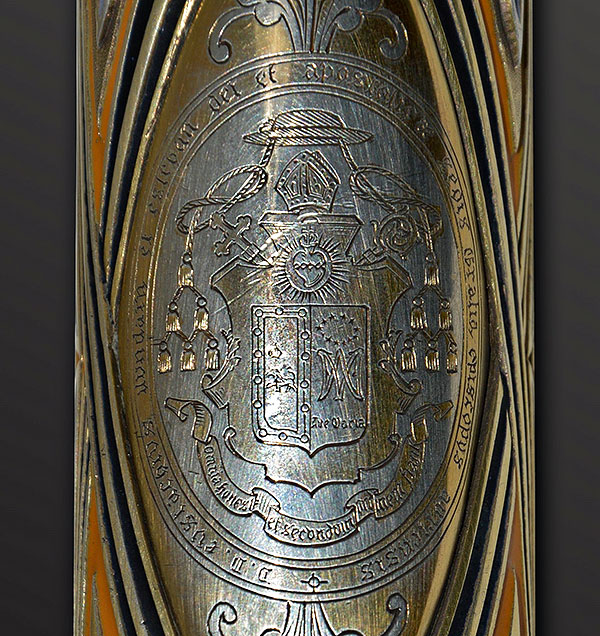The piece of the month of October 2022
A PIECE FROM THE LIONESE WORKSHOP OF ARMAND-CALLIAT IN THE PARISH OF SAN LORENZO IN PAMPLONA: THE EPISCOPAL CONSECRATION CROSIER OF EUSTAQUIO ILUNDÁIN OF 1905.
Alejandro Aranda Ruiz
Cultural Heritage. Archbishopric of Pamplona and Tudela.
The social phenomenon of episcopal consecrations and their artistic repercussions
The successive episcopal consecrations of Navarrese bishops that took place during the first third of the 20th century were experienced by part of the province and its capital as true events that highlighted the extraordinary strength of the Catholic faith in these lands and its special link with the Holy See. Consequently, these events transcended their religious character to become authentic social phenomena. The consecration in 1905 of Eustaquio Ilundáin y Esteban is a good example of this.
Well, in 1905 the city celebrated, amid great pomp, the assumption of the episcopal dignity of two sons of Navarre, that of Don Francisco Javier Baztán y Urniza, preconized bishop of Oviedo and native of Sada, and that of Don Eustaquio Ilundáin y Esteban, from Pamplona, preconized bishop of Ourense and who would eventually become cardinal of the Roman Church and archbishop of Seville, where he would die in 1937. The solemn consecration ceremony took place on the morning of March 13 in the chapel of the Virgen del Camino in the parish of San Saturnino de Pamplona (Tovar, 1942, 31).
On the occasion of the happy event and following the custom, the newly elected bishops were entertained by friends, relatives and acquaintances, and political and religious institutions with numerous gifts. These gifts consisted mostly of representative pieces of the episcopal trousseau, which the new bishops had to provide themselves with, thus saving them a considerable economic outlay, since many of these pieces were works of jewelry and goldsmithing of high cost.
In its issue corresponding to March 24, 1905, the magazine La Avalancha published a review of the gifts that don Eustaquio received, highlighting among all of them, due to its special link with the episcopal dignity, the crozier given by several friends of Pamplona, of which the newspaper distributed a photograph and a brief description. According to the published text, the crosier
is of gilded silver, enriched with exquisite enamels and engravings and has been made in Lyon by order of the reputable jewelry shop of Mrs. Ferreira's widow of Pamplona, its cost amounting to 2,461 francs. The Pamplona friends of Mr. Ilundáin, Bishop of Orense, have wanted to show him the affection and affection they feel for him, giving him this beautiful and useful jewel as a souvenir of his episcopal consecration.

Bishop Eustaquio Ilundáin y Esteban's crozier made by Armand-Calliat in 1905.
Pamplona, parish of San Lorenzo. Photo: Alejandro Aranda.
The genesis of the work and its author: Joseph Armand-Calliat (1862-1938)
Thanks to the aforementioned issue of La Avalanche, we know that the crosier was made in Lyon. However, it is the piece itself that further specifies its provenance, since the ring on the top of the cone on which the crosier rests on the ground reads: "ARMAND-CALLIAT FILS ORFÈVRE A LYON" (Armand-Calliat Son, silversmith in Lyon). The crozier can thus be linked to the production of Joseph Armand-Calliat (1862-1938), son of the also goldsmith and silversmith Thomas-Joseph Armand-Calliat (1822-1901). Trained at the Lyon School of Fine Arts and in the workshop of Gourguillon, in 1891 he became associated with his father in the goldsmith's workshop that the latter ran in the Lyon city (Berthod et al., 2015, 84). The origin of this workshop was to be found in the marriage formed in 1853 between Thomas-Joseph Armand and Jeanne Calliat. The latter had inherited from her father a silversmith's workshop which he took over position Thomas-Joseph in the company of his wife and sister-in-law, renaming it with the name of the two families: Armand-Calliat (Berthod et al., 2015, 80).
Armand-Calliat's productions soon stood out for their designs and careful execution, making a niche for themselves in the sacristies of the main sanctuaries (Lourdes, Montmatre), monasteries (Solesmes) and temples of France and Europe, including the Vatican Apostolic Palace. To this diffusion undoubtedly contributed the universal exhibitions, such as those of 1862, 1867, 1878, 1889 and 1900, in which Thomas-Joseph was awarded (Berthod et al., 2015, 80). At his death in 1901, he became position of the family business his son Joseph, who is the one who signature the Bishop Ilundáin's crozier. This crozier participates in some of the novelties that Joseph brought to the production of the Lyon workshop, highlighting among them the incorporation of the modernist language or the employment of translucent enamels (Berthod et al., 2015, 84). We do not know for sure in which part of the creative process of the crozier Joseph Armand-Calliart participated, but it is very possible that he can be attributed the design, corresponding its execution to one or some of the numerous craftsmen that the house had.

Bishop Eustaquio Ilundáin y Esteban's crozier, detail of the author's signature : "Armand-Calliat fils orfèvre a Lyon". Pamplona, parish of San Lorenzo. Photo: Alejandro Aranda.
On the other hand, the information provided by La Avalancha that the staff was acquired in the Pamplona jewelry store of Viuda de Ferreira gives us an idea of how this subject pieces could be made. This jewelry shop, founded in the mid-19th century by the Madrid family of the Ferreira family, was inherited by Pilar Idoate, who in the 1920s ended up giving a new name to the business, which is now known as Joyería Idoate. It is possible that this establishment could have been one of the "authorized representatives" of the House of Armand-Calliat in Spain, following the usual custom of the time followed by some large workshops. Thus, the commissioning of the crosier was carried out from this Pamplona jeweler's shop, where friends of the new bishop would go. The jewelry shop, placed in contact with the Lyon workshop, would request some designs. In this regard, it should be emphasized that Armand-Calliat, unlike other firms, was not supposed to have catalogs, but his work was photographed as production progressed, these photographs being placed in albums for their enquiry (Berthod et al., 2015, 80). In this way, don Eustaquio's friends could well have made a commission based on a photograph of a previously elaborated crozier or a drawing made ad hoc. Once the design was chosen and the observations concerning the coat of arms of the prelate or certain iconographic details were made, the work would later be executed in the workshops of Lyon.
The staff of Don Eustaquio Ilundáin
This is the crosier that, after the death of Cardinal Ilundáin in 1937, is preserved in the parish of San Lorenzo in Pamplona, where the prelate was baptized on September 21, 1862 (Tovar, 1942, 13). The piece, made of gilded silver of the same color and garnished with green, blue and yellow enamels, is formed by a circular rod articulated in two removable cylindrical cannons topped by a volute, also removable. These barrels are divided, in turn, into four sections separated by rings decorated with pearls and enameled motifs. The volute, for its part, is articulated in two halves. The first consists of a sort of prolongation of the rod in which a variegated enameled decoration frames the coat of arms of Bishop Ilundáin, on one side, and a representation of the Sacred Viscera, on the other, both motifs inscribed in an almond or mandorla and engraved on the metal, combining in them the gilded silver and its color. This part is finished with a kind of circular knot or macolla with the edges decorated with pearls that frame blue and green enameled motifs. In each of its four fronts, the knot has two shields with the representation of a vase with three flowers, made in colored enamels on a background of golden silver. Above this knot rises the scroll itself, in which the vegetal forms and motifs, accentuated by the employment of green and blue enamels combined with the gilded silver and its color, are the protagonists. In the middle of the volute stands out, as the main element, the figure of a dove.

Bishop Eustaquio Ilundáin y Esteban's crozier, detail of the volute. Pamplona, parish of San Lorenzo.
Photo: Alejandro Aranda.
As a whole, the staff stands out for its elegance, finesse and exquisite execution. In spite of some neo-medieval traces, stylistically it is ascribed to modernism, as can be seen at sample in the taste for geometric and vegetal motifs combined with colored enamels, among which green, the color par excellence of Art Nouveau, stands out.
The crozier: image of the prelate
From an iconographic point of view, the crozier is striking for its iconographic richness, very much in tune with the works produced by Armand-Calliat, conceived by their authors as a "mystical poem" (Berthod et al., 2015, 80 and 84). Consequently, the piece reflects the character and life trajectory of Bishop Ilundáin, as well as some detail regarding the virtues that should characterize a good bishop. In relation to the latter, it is worth mentioning the dove on the scroll, which may have an ambivalent meaning. On the one hand, it would represent the Holy Spirit that should always guide and inspire the action of the bishop. On the other hand, this small bird would also symbolize the virtue of humility, according to committee , which Christ gave to his apostles, whose successors are the bishops, that they should be as shrewd as serpents and as humble as doves (cf. Mt 10:16). It was not for nothing that, in the examination of the bishop-elect at the consecration ceremony, the consecrator asked the consecrated person about his willingness to preserve humility and patience in himself and to teach it to others (Fonoll, 1941, 30).

Bishop Eustaquio Ilundáin y Esteban's crozier, detail of the coat of arms of the prelate.
Pamplona, parish of San Lorenzo. Photo: Alejandro Aranda.
But the most representative motifs of the crosier are those that make reference letter directly to the recipient of the piece. In this sense, the speaking element par excellence is the coat of arms of the prelate, for whose execution Armand-Calliat must have been provided with an episcopal seal that the French goldsmiths reproduced exquisitely. Thus, the coat of arms appears inside a circle surrounded by the legend written in Gothic characters: "D. D. D. Eustachius Ilundain et Esteban Dei et Apostolicae Sedis gratia episcopus Auriensis" (Mr. Don Eustaquio Ilundáin y Esteban, by the grace of God and the Apostolic See, bishop of Ourense). In the middle is the coat of arms inscribed in a cartouche of twisted leathers crowned by the Episcopal crest with six staggered tassels on each side. The shield is divided into two quarters representing the arms of Pamplona, on the left, and the anagram of Mary with a crown of twelve stars and the legend "Ave María", on the right. Above the shield and within the cartouche of twisted leather, there is a heart surrounded by thorns and surmounted by a cross between flames that symbolizes the heart of Christ. Behind the cartouche of twisted leather, flanked by the cross and the crosier, is the mitre. Finally, at the foot of the shield, a phylactery contains the episcopal motto of Ilundáin, taken from the first letter of St. Paul to the Corinthians (14:20): "Omnia honeste et secundum ordinem fiant" (let everything be done with decorum and order).
This set of elements makes reference letter to two fundamental questions. In the first place, the coat of arms of Pamplona refers to the capital of Navarre as the birthplace and priestly training of Ilundáin. The bishop himself, after his election to the mitre of Orense, addressed a petition to the City Council of Iruñea requesting authorization to include the coat of arms of Pamplona in his episcopal coat of arms "as a tribute of love to his hometown and as a mark of glory for him, since he would consider himself very honored to bear it". In addition, the coat of arms of Pamplona would be a reminder of the patronage that the City Council of Pamplona had exercised in his episcopal consecration in 1905. Likewise, as Ilundáin himself explained to his diocesans, "the rampant lion and the chains [...] represent the strength that animated the Navarrese in the memorable battle of Navas de Tolosa, and which I long to have until I breathe my last" (Tovar, 1942, 37). On the other hand, both the anagram of Mary with her crown of stars and her registration, as well as the reference letter to the Sacred Heart, also present in the coat of arms, were visible elements of the love that the prelate professed for the Virgin and the Heart of Jesus, a devotion the latter manifested in the life of Bishop Ilundáin. Ilundáin, who during his student years founded the pious association of the Apostolate of the Prayer of the Sacred Heart of Jesus in several towns of Navarra and in the seminar of Pamplona, of which he became president (Tovar, 1942, 16 and 17).
As with the dove in the volute, the four vases of flowers in the macolla are susceptible to different readings. The first and most obvious is that of constituting yet another reference letter to the Marian devotion of Don Eustaquio, since the jar of lilies is one of the prototypical Marian iconographic motifs, alluding to the purity and virginity of the Mother of God. The second reading that could be made of this motif is a nod to the condition that Ilundáin held as a canon before attaining the episcopal dignity, first as magistral in Ciudad Real and later as archpriest in Segovia (Tovar, 1942, 18-23). In both cases, the coat of arms of the respective cathedral chapter was the vase of lilies.
SOURCES AND BIBLIOGRAPHY
file Municipal de Pamplona. Consultations, book 145 (1904-1905), ff. 97-98.
BERTHOD, B., FAVIER, G. and HARDOUIN-FUGIER, E., "Armand-Calliat Thomas-Joseph Armand, dit (1822-1901)", in Dictionnaire des arts liturgiques, Châteauneuf-sur-Charente, Frémur Publications, 2015, p. 80.
BERTHOD, B., FAVIER, G. and HARDOUIN-FUGIER, E., "Armand-Calliat Joseph (1862-1938)", in Dictionnaire des arts liturgiques, Châteauneuf-sur-Charente, Frémur Publications, 2015, p. 84.
FONOLL OLIVER, I. M., Ritual of the consecration of a bishop, Montserrat, Monastery of Montserrat, 1941.
"Idoate Jewelry: fine jewelry with personality and many carats of history" [accessed: 10/10/2022].
La Avalancha revista ilustrada, n. 241 (March 24, 1905), pp. 75 and 78.
TOVAR GONZÁLEZ, L., essay biográfico del Emmo. Señor Cardenal Ilundáin y Esteban, obispo que fue de orense y arzobispo de Sevilla, Pamplona, Aramburu, 1942.
